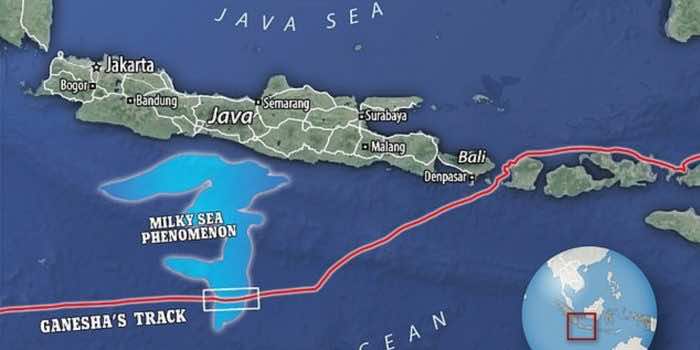A superyacht named Ganesha passed through a glowing milky sea in waters near Indonesia in the summer of 2019. The glow seemed to come from a source that was at least 30 feet below the surface.
The display was a result of ‘luminous bacteria communicating with each other and triggering a glowing response upon reaching critical populations via a process called quorum sensing,’ according to the documentation of events published in PNAS (Proceedings of the National Academy of Sciences).
‘Both the color and intensity of the glow were akin to glow-in-the-dark stars/stickers, or some watches that have glowing parts on the hands … a very soft glow that was gentle on the eyes.’
The first report of a milky sea came from an American ship sailing through the same area around Indonesia, near Java, on July 27, 1854.
They are believed to appear at most twice a year and sometimes not at all.

The images of the 2019 milky sea were captured in August, as captained by Johan Lemmens with six other crew members who started on a circumnavigation of the globe.
‘Ganesha entered these glowing waters suddenly, and, thereafter, the entire ocean was significantly brighter than the night sky—maintaining a mostly homogenous and steady glow to the horizon, said one of the crew members in an interview.
‘A bucket sample of these waters, whose collection did not disrupt the illumination at that location, contained several pinpoints of steady glow that darkened upon stirring—a behavior opposite to that of “normal” bioluminescence.
‘Likewise, the crew noted a darkened bow wave, but the ship wake had no perceivable change in brightness from the surrounding glowing waters.’
The crew captured the scene with a Go-Pro camera and a higher-quality Samsung Galaxy S9+ phone camera, and satellite imagery from the same day was collected to confirm that the encounter was a milky sea.
‘The saturation in these digital images was increased to an intensity consistent with the crew’s recalled perception,’ according to the report.
‘These photos give visual testimony to the written accounts of mariners across the centuries.’
Steven Miller, a professor of atmospheric science at Colorado State University in Fort Collins, told The Guardian that the milky sea lasted for at least 45 nights.


